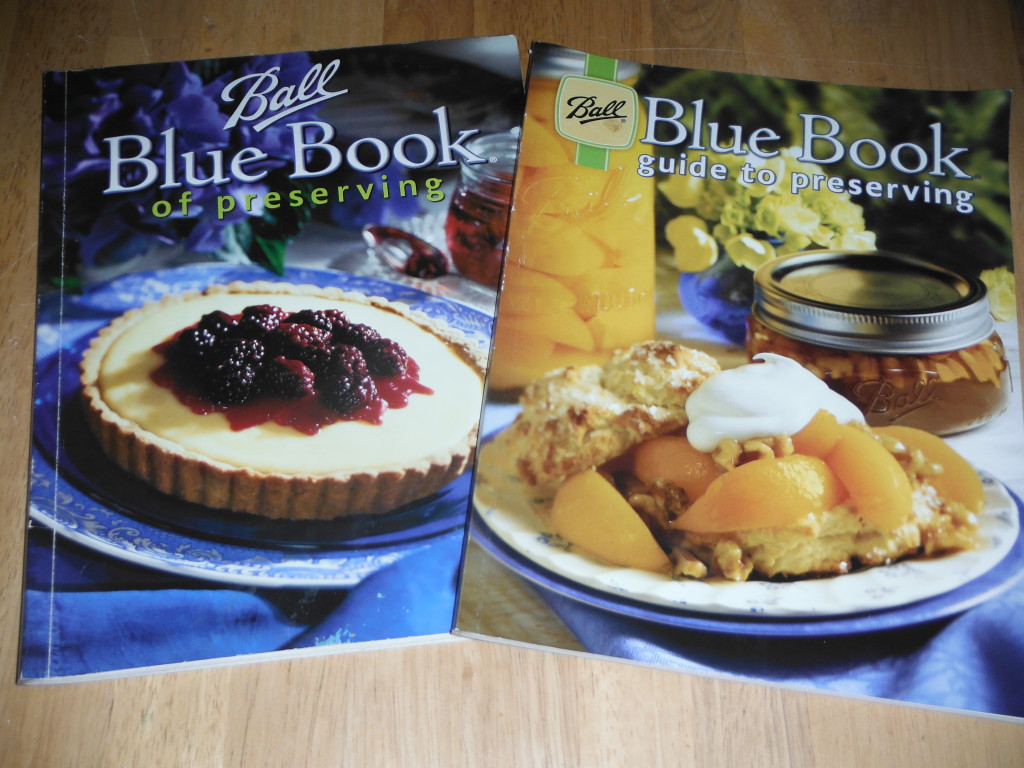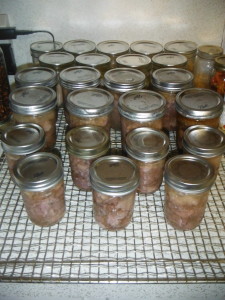As I sit here typing this out, I can hear the pressure canner merrily rattling along every twenty seconds or so. Pork butts and chicken thighs were on sale this week, and I took the opportunity to put some up the old-fashioned way, pressure canning it.
I will go over the general process, but I won’t go into details here. The process is covered far better in the “Bible of Canning”, “The Ball Blue Book Of Preserving“. They cover water and pressure canning, freezing, and dehydrating, and do it very well. I cannot stress how great a resource this book is, if you ever plan on preserving your own food. I believe anyone that has ever cooked a meal should own a copy of this book. I personally own two
First, read through the book and get a general idea as t what you want to preserve. We eat a lot of canned meat, both store bought and home preserved, so I like to put up meat whenever I am able to do so. We also like jams, salsas, relishes, marmalades, vegetable juices, hot sauces, the list goes on and on. There are more ideas in this small book than there is time to try them all. But go through and find something you want to try.
In this case, I wanted to preserve some of that meat I picked up while it was on sale. Since meat is a low-acid product, it requires a pressure canner in order to prevent botulism. I pressure canner allows the product to reach temperatures of 240+ degrees Fahrenheit, while a water bath canning can only achieve around 212 degrees. The extra heat makes all the difference in a achieving a safe end product.
Our canner is probably the most talked about, most popular, and most recognized pressure canner on the market, the All American 921 21 -1/2 quart Pressure Cooker/Canner. It is an aluminum, metal to metal seal, heavy duty monster of a pressure canner that has quickly proven itself as to why it is so popular. While it is priced at around $200, much like my Excalibur Dehydrator, it is worth the money, and makes me happy that I didn’t cut any corners and tried a cheaper alternative.
So with canned meat as the end product in mind, I had the directions from the the The Ball Blue Book Of Preserving, I had the All American 921 21 -1/2 quart Pressure Cooker/Canner for the processing, I had the meat to be processed, the only other thing left was jars, lids, and rings. Those I have plenty on hand (though I’m always looking to get more). I did grab a a few canning-specific tools from my “home canning kit“, and was ready to get started.
Since I had chicken thighs and a whole pork butt to deal with, I decided to start with the chicken, as it required no cutting to get started, while the pork butt would need to be deboned and cut into manageable chunks.
I was hoping to get a chicken thigh into a half-pint jar, but they didn’t fit sadly. I was hoping to make a compact, shelf stable jar with a chicken thigh and some broth so that I would carry it with me as a snack while working on the road. Great idea, only a chicken thigh is larger than a half pint. Maybe I’ll look into trying it with wings some day…
So I grabbed my pint jars, and went to work, following the directions (Page 59, “Chicken, Duck, Goose, Turkey, Game Birds”) for “Raw Pack”, the process of putting raw meat into the jars instead of cooked meat. The way I figure it, cooking meat, then pressure canning it is simply cooking it twice. The texture of canned meat (store bought and home processed both) already suffers when compared to fresh meat. By using raw-pack, you only cook it once, versus the two times it gets heated with the hot pack method. Simply put, hot pack pushes the quality of the texture beyond what I like. This is simply my preference. Hot pack does add an additional layer of flavor, so there is a trade off.
So raw packed meat, follow the pressure canner guidelines for processing at 10 pounds for the required amount of time (again, refer to the Ball Blue Book for the guidelines!).
Please note: I read the directions for the pressure canner and for the recipe EVERY time I do this. Food safety is not to be taken lightly. I’d rather spend 5 minutes reading over the directions that I’ve read hundreds of times already than to expose myself, my family, or my friends to an unsafe food product of my making.
While the chicken was processing, I started cutting up the pork. About the same time that the pork was put into the jars, again raw pack (Page 59, “Stew Meat”), the chicken was finishing its time in the pressure canner. After the proper amount of time allowing the canner to vent steam, and equalize the pressure, I was able to remove the jars of chicken, placing them on a cooling rack, then restart the pressure canning process with the pork.
I’ve found that the effort needed to do a single batch of pressure canned food is a pretty big undertaking for one person for an evening. Plan on at least two hours of your time being devoted to what needs to be done. However, adding a second batch only adds an additional 45 minutes or so, possibly less (and not counting the processing time, that is simply waiting). So whenever I plan on pressure canning, I try to arrange at least a second batch of something, and on a good day, three or four batches total.
On the scale of difficulty, pressure canning meat is about as difficult as making a cake…from a boxed mix. Once you have the proper equipment, it really is a breeze. And the end results will last you for years, and will provide a way to capture today’s excess for tomorrow’s need.
Peace,
db
As always, please “like” FloridaHillbilly on Facebook, subscribe to my feed, sdd it to Google+, Pinterest, Linkdn, Digg, and/or tell your friends! The more folks that start preparing themselves, the less likely they are to invite themselves over for a “free” fish dinner!
Need something from Amazon (and who doesn’t)? I earn a small commission from purchases made when you begin your Amazon shopping experience here. You still get great Amazon service and the price is the same, no matter what.



Wow, thanks for the detailed info. I have been wanting to try to can meats but I have been too chicken. LOL… For the most part we have been storing away freeze dried meat and chicken from www. srmarketplace .com. We really like the taste and that it has a very long shelf life without refrigeration. I love the Ground Beef!! I’ll be looking for a sale this week and give home canning a try.
It really is simple, just be sure to follow the directions both in the Ball Blue Book, as well as your pressure canner’s manual